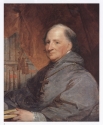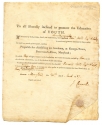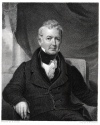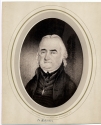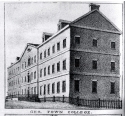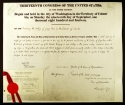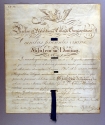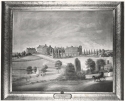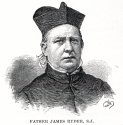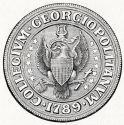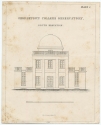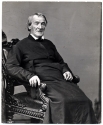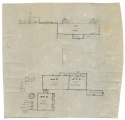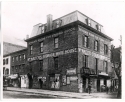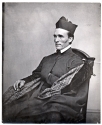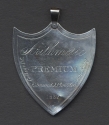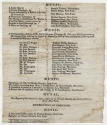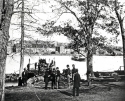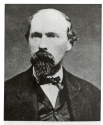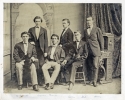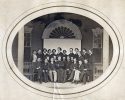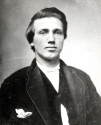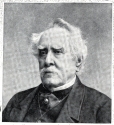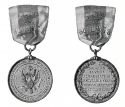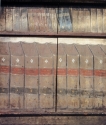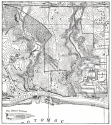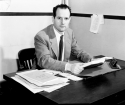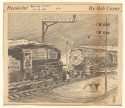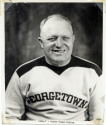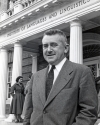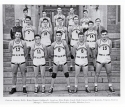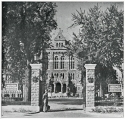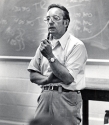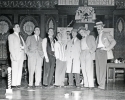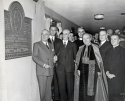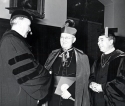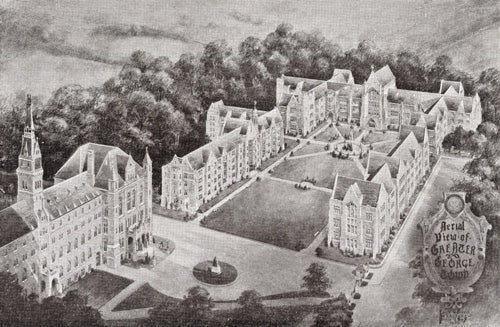
Visions of Georgetown showcases over 200 years of Georgetown history. Through a variety of photographs and illustrations featured in historian Robert Emmett Curran’s three-volume work, the exhibition documents Georgetown’s evolution from an academy within the American Catholic community of the Revolutionary War era to an internationally recognized research university.
Lauinger Library celebrates its 40th anniversary and the launch of Curran’s three-volume History with an event on October 28, in conjunction with the Georgetown University Press. Beacons of Learning: Georgetown University and Lauinger Library features Professors R. Emmett Curran, John J. Glavin and Provost James J. O’Donnell discussing the past, present and future of the Library.
Facsimile of broadside proposing the establishment of Georgetown.
Facsimile of broadside proposing an Institution whose “Plan of Education solicits, and it is not Presumption to add, deserves public Encouragement.”
Facsimile of fund solicitation, 1787.
Facsimile of the fund solicitation that in 1787 went to each prospective donor “inclined to promote the Education of YOUTH,” along with a copy of the Proposals for establishing an Academy at George-Town. In this notice, Carroll declares himself the official underwriter of the institution whose establishment he had been considering on and off for more than three years.
John Carroll’s Episcopal seal adopted in 1790.
The design incorporates an image of the Blessed Virgin and the keys of Peter, the two he selected as patrons of the nation’s first bishopric. The Virgin is surrounded by thirteen stars that represent each of the United States of America. After his consecration, John Carroll published “A Short Account of the Establishment of the New See of Baltimore in Maryland,” as well as the discourse delivered on the occasion of his consecration at Lulworth Castle, a translation of the authorizing papal bull, and extracts from the Bill of Rights of some of the States. (From The Life and Times of Archbishop Carroll by John Gilmary Shea.)

Robert Plunkett, first president of Georgetown, from 1791 to 1793.
This is a presumed likeness painted in the late nineteenth century from eighteenth-century descriptions. The original painting is part of Georgetown University's Art Collection.
William Gaston (1778–1842).
Gaston was the first student and is here portrayed in the mid-1830s at the height of his long and distinguished career in public service. (By G. Cooke, engraving by A. B. Durand, courtesy of the Library of Congress)

"Ratio Studiorum", 1586.
The first printing of the “Ratio” (1586) was published by the Society of Jesus and distributed from Rome to the Jesuit provinces throughout the world for classroom trial and comment. This rare, preliminary edition is the only known copy in North America. The book is part of the Rare Book Collection in the Special Collections Research Center at Georgetown University. (Purchased with funds generously provided by Mrs. S. R. Straske, Paul Straske, and Homer Hervey.)
Robert Molyneux (1738–1808).
As a former Jesuit and emigré from England, Molyneux served as the second president of Georgetown from 1793 to 1796. As a Jesuit in the restored Society, he again served as Georgetown’s fifth president from 1806 to 1808. This presumed likeness was painted about eighty years later from descriptions of the erudite Englishman. (Shea, Memorial)
Old North, Georgetown’s second major academic building.
Old North was begun in 1794 and completed in early 1797. It was here, on the front porch, that former President George Washington was formally received and introduced by President DuBourg to the students in August 1797.
William Louis DuBourg (1766-1833)
William Louis DuBourg, third president of Georgetown from 1796 to 1798, was one of several erudite Sulpicians who contributed significantly to the growth of that “complete nursery of learning.” The courtly emigré also raised that “nursery” from academy to college during his brief but energetic tenure. (Engraving from Shea, Memorial, 23)
Rt. Rev. Leonard Neale, D.D. (1746–1817).
As fourth president of Georgetown, Neale served from 1799 to 1806. With his help, Alice Lalor, an Irish emigré, and two companions opened Visitation Academy for the education of young ladies.
Francis Neale, SJ (1754–1837).
Neale served as acting president of Georgetown from December 1808 to March 1809, and as president from 1810 to 1811.
William Matthews (1770–1854).
A nephew of Francis and Leonard Neale, he was president of Georgetown for about seven months in 1809.
Facsimile of Georgetown’s federal charter, signed by President James Madison on March 1, 1815.
The Act was presented to the U.S. Congress for consideration by Congressman William Gaston, loyal alumnus.
John Carroll (1735–1815).
Priest, prelate, patriot. Bishop from 1790 to 1808. Archbishop from 1808 to 1815.
Title page of "A New Treatise on the Use of the Globes and Practical Astronomy or a Comprehensive View of the System of the World" by J. Wallace.
J. Wallace joined the faculty at Georgetown in 1805 as a mathematics teacher. His textbook on astronomy, which he wrote initially for his students at the New York Literary Institution, was used at Georgetown long after he left the College in 1818.
Charles James Faulkner (C1815–22).
Faulkner had a long and distinguished career in public service, first in the Old Dominion’s House of Delegates, then in the U.S. House of Representatives, and finally in the diplomatic corps of the United States.
Thomas Levins (1789–1843).
Levins was an Irish emigré and professor of science and mathematics at the College. Despite his dismissal from the Society in 1825, the scholarly Levins eventually bequeathed his library to Georgetown. This image is a photograph of a Lithograph from a print made by R. Bowen when Levins was rector of St. Patrick’s Cathedral in New York City.
The College Walks.
Wintertime approach to the College Walks designed by Brother West. They graced the campus for more than a century, until the land had to be used for buildings.
Washington City seen from Georgetown in the 1830s.
Photograph of a drawing by J. Smith, engraving by J. B. Neagle, 1832.
Georgetown in 1830.
Black & white photograph of painting by James Simpson. The original painting is part of Georgetown University's Art Collection.
Old College Shop.
Constructed in 1810, this small brick building housed Georgetown’s shoe shop, store, and bakery. (Photograph probably taken several decades before it was razed in 1908; Georgetown University Archives).
Thomas Mulledy, SJ (1794–1860).
Trained in Rome and twice president of Georgetown, he always cherished the wearing of the “freeman’s wreath” in America. Photograph from an 1840s daguerreotype.
Susan Wheeler Decatur (1776-1860)
Decatur, widowed in 1820 by her husband’s death in a duel, became one of Georgetown’s great benefactors. The portrait, attributed to Gilbert Stuart, is in the collection of Mr. and Mrs. William Machold. (Georgetown University Archives)
James Ryder, SJ (1800–1860).
Twice president of Georgetown, Ryder was also an elected Resident Member of the Smithsonian Institution and one of the most renowned Catholic preachers in antebellum America. (Shea, Memorial)
The College Seal
Thought to be derived from DuBourg’s design, it was formally adopted for legal use when Georgetown was formally incorporated by an Act of Congress in 1844.
Architect’s rendering of the Astronomical Observatory’s south elevation.
View as seen when facing the ridge on which Georgetown’s “lighthouse of the skies” was sited in 1843.
Cross section of Georgetown’s observatory.
Rendering shows the transit instrument, the equatorial telescope, the meridian circle, and the granite piers sunk in the three-foot-thick masonry foundation embedded in the ridge at the Hilltop.
James Curley, SJ (1796–1889).
The first director of the Astronomical Observatory, and, for nearly sixty years, a member of the college faculty, is seated in the chair presented to him by President Abraham Lincoln. Photograph taken about 1865 by Mathew Brady.
Map of the main campus in 1853.
It should be noted that the Observatory is not sited in this area. Plotted and drawn by Father Curley.
First building used by Georgetown’s Medical Department.
Constructed in 1850–51 and used until 1869, the Medical Department’s first building was at the corner of F and 12th Streets NW, in Washington, DC. Photograph taken ca. 1885.
Medical Department Faculty, ca. 1867.
The faculty of the Medical Department pose for a group photograph. Front row (from left to right): Silias Loomis, James Morgan, Johnson Eliot, Noble Young, Flodoardo Howard, and Thomas Antisell. Back row: Danie Hagner, Robert Reyburn, and John Harry Thompson. Photograph taken ca. 1867 by Alexander Gardner
James Ryder Randall (C1848–56).
Known in the ranks of the academy as “Little Buster” when he was nine years old, and the author of the song “Maryland, My Maryland.” He was a resolute and articulate Southern patriot. Photograph taken ca. 1861.
Scribner’s Magazine Cartoon, 1880.
During the postbellum years, unlike during the Ryder years, senior students were permitted to smoke but only in certain areas of the Georgetown campus. Cartoon from 1880.
Georgetown Waterfront, 1865.
The waterfront of the port of Georgetown changed little in physical aspect from about 1840 to 1865, although some cultural changes gradually became evident in the city and on the Hilltop. Photograph taken by William Smith.
Exhibition Program, 1821.
This 1821 program “exhibits” the liberal studies that dominated Georgetown’s curriculum from the beginning and that, throughout the nineteenth century, continued to be integral to an education with an overall coherent plan and system “by which truth may be sought and acquired.”
Arithmetic Premium awarded for mathematics to one of two top students at the exhibition (commencement) for the Class of 1832
Georgetown Cadet Corp Staff Officers, 1867.
Like their counterparts in other American colleges, these staff officers of the Georgetown Cadet Corps were mature, responsible collegians who wore their uniforms proudly. Photograph taken in 1867.
Handbill for an early performance of Sheridan’s “Pizarro”, 1853.
The performance was produced by the Georgetown College Dramatic Association, with music by the Philharmonic Society of “G.T. College.” B. J. Semmes was cast as Iago, with James R(yder) Randall, George Hamilton, and Hugh J. Gaston among the other luminaries.
Commencement Program, 1817.
This somewhat battered and annotated commencement program details the order of exercise for the first conferring of degrees in July of 1817. Charles Dinnies is listed as the salutatorian and his brother George as the valedictorian. Frederick Barber, their classmate, was absent because of the death of his father and did not receive his degree then. The exercises were held in Old North.
Federal troops “at ease” on the Virginia side of the Potomac, sometime after the Battle of Gettysburg.
Georgetown’s buildings are visible on the hilltop (left of the tree) above the Aqueduct Bridge.
John Early, SJ (1858–65).
Twenty-fifth president of Georgetown and its firm, resolute leader during seven tense and often difficult years for students and faculty. Photograph taken ca. 1875.

John E. Dooley (C1856–61).
CSA, First Virginia Infantry, ca. 1863.
Union soldiers ferried supplies from the Georgetown port to their encampment on Analostan (now Roosevelt) Island
Photograph taken ca. 1865.
Daniel Robert Brower (M1864).
Detail from a photograph of the completed college wall with shanties below on Warren (Thirty-Seventh) Street.
Photograph taken ca. 1867.
The Class of 1869—Georgetown’s most notable class in the nineteenth century.
Those identified include Walter Abell, seated at the right; Stephen Mallory, seated at the center; Henry Walters standing at the right; and James Coleman, standing at the left.
The College Sodality.
Robert Douglas, son of Senator Stephen Douglas, is seated third from the left, next to the Jesuit moderator. Photograph taken by Alexander Gardner, ca. 1865.
Thomas H. Stack (C1866–68).
Afterwards, as a Jesuit, he became president of Boston College. Photograph taken ca. 1872.
Francis Barnum (C1866–72).
Afterwards, as a Jesuit, he became a missionary to Alaska. Photograph taken ca. 1868.
The Georgetown College Nine of 1875–76.
Seated, from left to right: B. Campbell McNeal, Thomas J. Timmins, John Carroll Payne (captain), and Francis W. Dammann. Standing, from left to right: John Giraud Agar, James B. Risque, Edward A Dolan, Thomas F. Mallan, James P. Dolan. Photograph taken ca. 1875.
Program for Law Department’s first commencement in 1872.
The dean, Justice Charles James, addressed the first ten graduates at Lincoln Hall. The degrees were conferred by President John Early after the reading of the Act of Congress (March 1, 1815), which had raised Georgetown College to a University.
The New Building in 1880.
Shows the huge, frontal mound of dirt from the excavation work. Funds for removal of the unsightly mound and the building’s completion were not available until shortly before the Centennial Celebration in 1889.
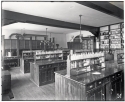
Detail from a photograph of the chemistry laboratory.
The laboratory is probably as it was used from 1880 onward. Photograph taken ca 1890.
Bookplates.
They were placed in books provided by the student societies that maintained the Students’ Library (two bookplates shown here of about a dozen).
The Georgetown crew training on the Potomac.
University buildings appear on the Hilltop to the left of center, and the town’s buildings and wharves are shown to the right at the river’s edge. Photograph taken ca. 1881.
Members of the Mandolin Club.
Like their collegiate “musical ancestors” of the 1870s and 1880s, these members of the Mandolin Club were an established part of Georgetown’s social life. Photograph taken ca. 1896.
Georgetown’s faculty ca. 1890.
Among those in the first row are George Magruder (third from left), L.W. Lovejoy (fourth from left), president of the faculty (center), Joseph Tabor Johnson (fourth from right) and Carl Kleinschmidt (fifth from right).
The Law Department’s fourth building at Sixth and F Streets, NW., Washington, DC.
Photograph taken ca. 1884.
The Society of the Alumni at the Centennial on February 21, 1889.
In the first row, sixth from the left is James Doonan, seventh from the left is Joseph Havens Richards, eighth is Martin Morris, ninth is George Hamilton. In the third row from the top, Robert Ray is second from the left, with his right arm on the porch post.
The Medical Department’s new building on H Street, NW, Washington, DC, in 1886.
Engraving from ca. 1887.
Obverse (left) and reverse (right) of the Alumni Medal of the Centennial.
Designed by William F. Quicksall (C1861) and produced for die stamping by Francis A. Cunningham (C1864). The medals were issued as a memorial of the formal celebration in February 1889.
Distinguished guests and faculty assembled on the porch of Old North during the celebration of the centennial.
Photograph taken ca. 1889.
Black and white detail of the full-color trompe l’oeil painting by James Simpson in 1831 on the library door of Old North.
Map of the Georgetown campus.
Detail from a map of the District of Columbia plotted and drawn by the U.S. Coast Survey in the 1880s.
Joseph Havens Richards, SJ.
President of Georgetown, 1888–98.
Football squad of 1898.
The first year since the banning of football following the death of George Behan four years earlier.
Georgetown Hospital, which opened in 1898.
George Lloyd Magruder
Dean of the medical department from 1888 to 1901.
Law School building, 1891
Dahlgren Chapel of the Sacred Heart
Bailey Kelley Ashford, M 1896
Served as a surgeon during the Spanish-American War
Ryan Hall (1902
On the site of the original building demolished the previous year.
Description of the new scientific course in the catalog of 1915–16
Seismological station under the quadrangle.
Francis Tondorf, SJ, at the Observatory.
George Hamilton
Dean of the law school, 1900–1903 and 1914-41.
Law school annex on E Street NW, 1911.
George Kober
Dean of the medical school, 1901–28.
Original facility of the dental department, 1901.
The administrator of the hospital, Sister Pauline, OSF, and the first graduating class of the nursing school, 1906.
Dedication of the John Carroll statue, 1912.
Flag sewn by Visitation students that portrays Georgetown alumni in U/.S. service.
George Tully Vaughn
Professor of surgery in the medical school.
Student Army Training Corps in Ryan Gymnasium, 1918.
John B. Creeden, SJ.
President of Georgetown, 1918–24.
Dedication of the unfinished Georgetown Preparatory School building in Garret Park, MD, 1918.
Edmund Walsh, SJ, dean and regent of the School of Foreign Service, 1919–56.
Sketch of the planned first stage of “The Greater Georgetown,” the Edward Douglas White Quadrangle.
New North Building, 1925.
Invitation to the celebration of the fiftieth anniversary of the School of Law, 1920.
Walter Summers, SJ, regent of the Medical School, 1924–29.
Tallyho carrying fans to football game at the turn of the century.
John Sheridan poster for Yale-Georgetown baseball series, 1899.
Georgetown University–University of Virginia football game.
November 17, 1901, won by Georgetown 17–16.
Baseball championship squad, 1899.
Ryan Gymnasium, 1906.
Vincent McDonough, SJ, moderator of athletics, 1916–30.
Robert Legendre
The world record holder for the long jump (25 feet, 5 inches) in the 1920 Olympics.
Lou Little (left), football coach, 1924–29.
The Hoyas (on defense) in the 1928 season.
Inauguration of W. Coleman Nevils, SJ, as thirty-ninth president of Georgetown, 1928.
Medical-Dental Building, 1930.
White-Gravenor Building, 1933.
Joseph Solterer, professor of economics.
The Debating Society
Georgetown’s most successful team in intercollegiate competition in the interwar years.
Philip A. Hart (center), C1934, future U.S. senator. Joseph G. Smith, left; Jerome J. Downey, right.
Wallace Mason Yater M1921, first fulltime clinical professor.
David V. McCauley, SJ.
Regent and dean of the Medical School, 1934–46.
Dental students in lab in the 1930s.
Arthur O’Leary, SJ.
President of Georgetown, 1935–42.
Goertz A. Briefs
Professor of economics in the graduate school.
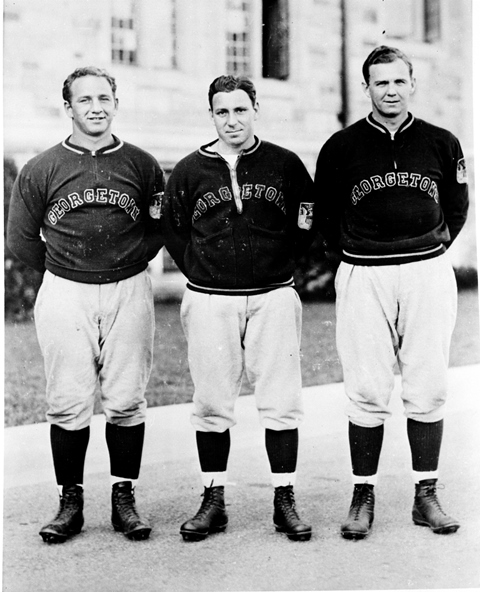
Football coaching staff: Maurice Dubofsky, Jack Hagerty, and George Murtaugh.

Georgetown University versus University of Maryland at Griffith Stadium during the undefeated 1938 season.
Cartoon depicting the upcoming game between unbeaten powers, Georgetown and Boston College, November 1940.
Konrad Adenauer, left.
Chancellor of West Germany, at his honorary degree ceremony in 1953 (Cardinal Patrick O’Boyle, center; Edward Bunn, SJ, right).

